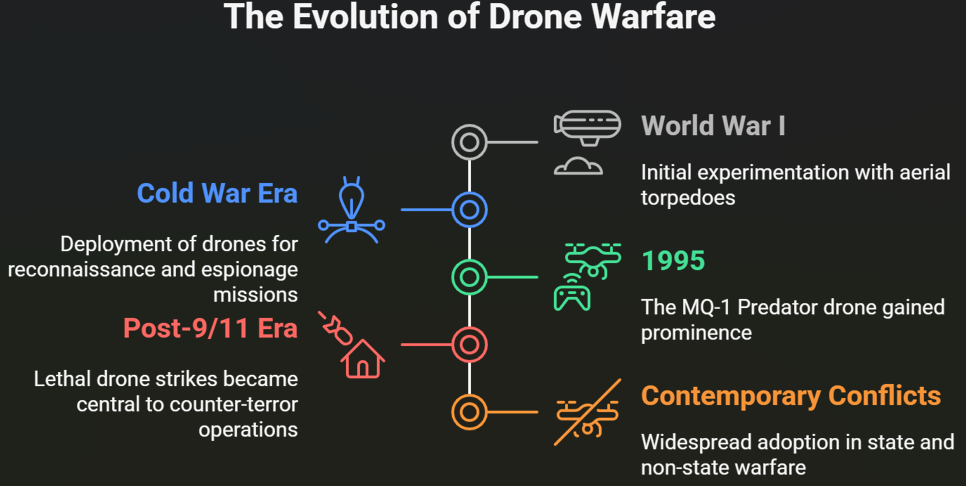Font size:
Print
How drones are the new face of Modern warfare
Context: India’s Operation Sindoor in the wake of the Pahalgam terror attack has marked a notable shift in the country’s adoption of Unmanned Aerial Vehicles (UAVs) in combat.
How are drones transforming modern warfare?
- Force Multipliers: They allow remote targeting, precision strikes, and real-time surveillance without risking pilot lives.
- Asymmetric Tools: Their low cost and adaptability enable even non-state actors or technologically inferior militaries to contest superior forces.
- Current applications: Additionally, UAVs are increasingly used in: Border surveillance and anti-smuggling operations,Targeted assassinations of high-value terrorist figures & Logistics in terrains inaccessible to conventional vehicles.

How do drones function in modern military operations?
- Surveillance and Reconnaissance: Equipped with cameras, infrared sensors, and radar, they provide real-time intelligence.
- Precision Strikes: Armed drones like MQ-9 Reaper deliver targeted firepower with reduced collateral damage.
- Logistical Support: Delivery of supplies, ammunition, and medical aid to isolated areas.
- Electronic Warfare: Disrupting enemy communications or radar via signal interference.
- FPV (First-Person View) Drones: Agile and small UAVs for urban combat and kamikaze-style attacks.
What technologies are employed in anti-drone warfare?
- Signal Jamming: Disrupting control or GPS links.
- Kinetic Kill Systems: Use of anti-aircraft weapons or drones to physically destroy UAVs.
- Drone-on-Drone Combat: Interceptor drones neutralise hostile UAVs mid-air.
- Directed Energy Weapons: Laser systems offer precise, scalable, and cost-effective anti-drone solutions.
What are the ethical concerns associated with autonomous drones?
- Delegation of Kill Decisions: AI-driven drones making life-and-death choices without human intervention.
- Lack of Moral Agency: Machines cannot understand or respect humanitarian values.
- Desensitisation to Violence: Risk of making warfare more impersonal and frequent.Loss of Accountability: In the absence of a clear human operator, assigning legal responsibility becomes complex.
What strategic shift does India’s Operation Sindoor reflect in drone warfare doctrine?
What is the future trajectory of drone warfare?
- AI Integration: Autonomous drones capable of mission execution with minimal human input.
- Swarm Technology: Coordinated attacks using multiple low-cost drones overwhelming defenses.
- Miniaturisation: Smaller, stealthier UAVs harder to detect and counter.
- Proliferation: Wider availability to non-state actors and rogue regimes.
Global Arms Race: Nations investing heavily in drone tech to avoid strategic disadvantages.
Operation Sindoor, launched after the Pahalgam terror attack, demonstrates India’s shift towards integrating drones with standoff weaponry in combat, marking:
- Doctrinal Transformation: A move from traditional manned responses to remotely piloted systems.
- Expansion of Strategic Ambiguity: It widens the scope for non-conventional retaliation without escalating to nuclear conflict, especially vis-à-vis Pakistan.
- Integration with Air Defence: India’s use of drones in both offensive and defensive roles (intercepting missile and drone attacks from Pakistan) underlines their dual utility.
What is the significance of the military-commercial crossover in drone technology?
The blurring line between commercial and military drones has:
- Lowered Entry Barriers: Commercially available drones are modifiable for offensive use with open-source software and cheap hardware.
- Expanded Asymmetric Warfare: Non-state actors like rebels and terrorists can exploit drone capabilities.
- Enabled Rapid Prototyping: Technologies like 3D printing allow mass-scale production of drone parts in battlefield zones (Ukraine, Myanmar).
- Challenges Conventional Security Models: Civilian airspace and public infrastructure are now vulnerable to attacks using repurposed drones.
Subscribe to our Youtube Channel for more Valuable Content – TheStudyias
Download the App to Subscribe to our Courses – Thestudyias
The Source’s Authority and Ownership of the Article is Claimed By THE STUDY IAS BY MANIKANT SINGH




